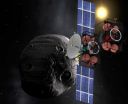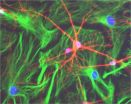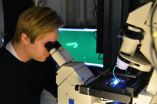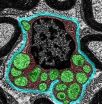(Press-News.org) AMES, Iowa – Bong Wie has heard the snickers.
You want to protect the Earth from asteroids? Where were you when the dinosaurs needed you? You want to be like Bruce Willis in that asteroid movie?
Wie has a serious reply: After five years of science and engineering work, Wie and his small team have a publication list of 40-plus technical papers, $600,000 of NASA research support and a proposal for a $500 million test launch of an asteroid intercept system. Plus, Wie has just been invited to show off his research as part of NASA's Technology Day on the Hill in Washington, D.C., on April 17.
"It's not a laughing matter," said Wie, the director of the Asteroid Deflection Research Center at Iowa State University and the Vance D. Coffman Faculty Chair and professor of aerospace engineering.
Recent events have certainly highlighted the threat of asteroid strikes. There was the 15-meter (49-foot) meteor that exploded an estimated 12 miles over Chelyabinsk, Russia, on Feb. 15, damaging buildings and injuring more than 1,000 people. That same day, the 45-meter (148-foot) asteroid 2012 DA14 passed within 17,200 miles of Earth.
"DA14 was a serious near miss," Wie said. "If that impact had happened, it would have been the equivalent of 160 Hiroshima nuclear bombs.
"Even though I say that so many times, people just laugh."
A two-punch defense
Wie's studies lead him to believe it will take a one-two nuclear punch to break an asteroid into harmless pieces when there isn't sufficient warning to use non-nuclear defenses. Here's how it would work:
A satellite carrying a nuclear device would be launched into orbit.
The satellite's trajectory would intercept an incoming asteroid that's 50 to 300 meters (164 to 984 feet) across, the typical size that threatens Earth. The satellite could travel up to 30 days to reach the asteroid.
The satellite would hit the asteroid at a speed of 10 kilometers (6.2 miles) per second, creating a large crater in the asteroid.
Just before impact, the nuclear device would be released from the back of the satellite, creating a slight delay in detonation and allowing the device to fly into the middle of the crater.
The explosion from inside the crater would blast the asteroid apart.
"The overall effect of an explosion under the surface is 20 times larger than an explosion on the surface," Wie said.
The asteroid chunks would spread into a large debris cloud. By the time Earth reached the cloud, Wie said less than .1 percent of the chunks would enter the atmosphere. And those should only be 5-meter (16-foot) pieces that aren't likely to do much harm.
But will it work?
"We have all the technology," Wie said. "We don't need anything new. But we need to engineer, integrate and assemble these technologies. And we need practice."
The Asteroid Deflection Research Center
Wie came to Iowa State in 2007 after a successful academic career researching spacecraft control and guidance. (He's the author of a textbook, "Space Vehicle Dynamics and Control," published by the American Institute of Aeronautics and Astronautics.)
He was looking for a new research direction and in 2008 was able to use some money from his Coffman Faculty Chair position to establish the Asteroid Deflection Research Center. Money from the Iowa Space Grant Consortium also supported the center during its early days.
There wasn't much of a research budget until the center won a $100,000 Phase I grant from the NASA Innovative Advanced Concepts program (NIAC) in 2011. The center won a $500,000 NIAC Phase II grant last fall.
Even with the grants, it's still not a big operation: There's Wie, there's John Basart, a professor emeritus of electrical and computer engineering who's volunteering his time, and there are eight graduate students.
Center researchers have published and delivered papers such as "Conceptual Design of a Hypervelocity Asteroid Intercept Vehicle (HAIV) and Its Flight Validation Mission" and "Guidance Algorithms for Asteroid Intercept Missions with Precision Targeting Requirements."
Basart has been busy studying and calculating the potential use of the Yarkovsky Effect to slowly redirect the orbital motion of an asteroid. The phenomenon takes into account heating cycles of an asteroid and how that solar energy can actually cause an asteroid's orbit to shift slightly.
"An intercept mission is not a trivial thing," Basart said. "It's terribly complicated. If we learn an asteroid is going to hit in a year, we don't have a lot of time to prepare."
But, he said researchers had better prepare.
"One thing we've learned in science over the last 50 years is how violent our universe is," Basart said. "Yes, we have a violent universe and it's important for our human race to plan for this. It's not a matter of if; it's when."
Iowans should know. A 2-kilometer (1.2-mile) asteroid struck what is now Manson some 74 million years ago. That impact created a crater, now buried well below the northwest Iowa topsoil, 22 miles wide and 3.5 miles deep. And geologists say recent aerial surveys have confirmed a 200-meter (656-foot) meteorite crashed into what is now northeast Iowa's Decorah some 470 million years ago. That impact left a crater – now underground – that's 3 miles in diameter.
A test mission
To date, Wie, his Iowa State research team and Brent Barbee of NASA's Goddard Space Flight Center in Maryland have been working with data generated by computer simulations. Wie said it's time to integrate the necessary technology, build an unarmed prototype satellite and launch an actual test to see if a target asteroid can be hit.
He thinks the answer is yes because NASA engineers and scientists have already accomplished a very similar mission.
In July 2005, the impactor from NASA's Deep Impact Mission crashed into Tempel 1, a comet that measures 7.6 by 4.9 kilometers (4.7 by 3 miles). The impact was designed to create a crater 25 meters deep (82 feet) and 100 meters wide (328 feet), exposing the comet's interior. The mission's flyby spacecraft passed over the crater to take pictures and collect spectroscopy data.
"We have done that with a large comet," Wie said, "but not with a 300-meter or a 50-meter asteroid."
And so Wie is writing up a proposal for a $500 million test mission.
"Now is the time to talk about a test mission," he said. "It is time to develop a plan and demonstrate this concept."
INFORMATION:
– 30 –
Contacts:
Bong Wie, Asteroid Deflection Research Center, Aerospace Engineering, 515-294-3124, bongwie@iastate.edu
John Basart, Asteroid Deflection Research Center, Electrical and Computer Engineering, 515-231-0469, jpbasart@iastate.edu
Mike Krapfl, News Service, 515-294-4917, mkrapfl@iastate.edu
Iowa State engineers developing ideas, technologies to save the Earth from asteroids
2013-03-07
ELSE PRESS RELEASES FROM THIS DATE:
INRS overcomes a hurdle in the development of terahertz lasers
2013-03-07
This press release is available in French.
Dr. Roberto Morandotti and his team at the INRS Énergie Matériaux Télécommunications Research Centre have developed a device that is critical to the use of terahertz (THz) sources for a variety of applications. Their electromagnetic non-reciprocal isolator is the subject of a recent article in Nature Communications, showing just how important this new development is. Until now, no isolator existed that was effective in the THz region of the spectrum, a situation that held back the development of certain technologies. The new ...
Star-shaped glial cells act as the brain's 'motherboard'
2013-03-07
The transistors and wires that power our electronic devices need to be mounted on a base material known as a "motherboard." Our human brain is not so different — neurons, the cells that transmit electrical and chemical signals, are connected to one another through synapses, similar to transistors and wires, and they need a base material too.
But the cells serving that function in the brain may have other functions as well. PhD student Maurizio De Pittà of Tel Aviv University's Schools of Physics and Astronomy and Electrical Engineering says that astrocytes, the star-shaped ...
Ketchup turns somersaults
2013-03-07
This press release is available in German.
The unusual behavior of complex fluids is part of our daily life: cake dough climbs up the stirring bar, ketchup becomes liquid when you shake it. Also technology uses such phenomena: if we add a small amount of long-chained polymer molecules, a pipeline can transport more oil. The polymers reduce the flow resistance. But up to now the origin of these effects was unclear. The engineers had to rely on estimates and lengthy trials.
A team of physicists led by Professor Andreas Bausch, Chair of Cellular Biophysics at TUM now ...
Mayo Clinic aids discovery of first dystonia gene found in African-Americans
2013-03-07
JACKSONVILLE, Fla. — A pair of studies tells the tale of how a neuroscientist at Mayo Clinic in Florida helped to discover the first African-American family to have inherited the rare movement disorder dystonia, which causes repetitive muscle contractions and twisting, resulting in abnormal posture. The research may improve diagnosis of this neurological condition in a population not known to suffer from it.
In the first study, published in 2011 in the journal Parkinsonism and Related Disorders, Mayo Clinic's Zbigniew Wszolek, M.D., and a team of neuroscientists from ...
Federal figures miss most work-related amputations
2013-03-07
A new report from Michigan State University and the Michigan Department of Community Health raises significant concerns about the federal government's system for tracking work-related injuries.
Published in the Journal of Occupational and Environmental Medicine, the study found the number of amputations following jobsite accidents in Michigan was nearly two-and-a-half times higher than the official estimate from the U.S. Bureau of Labor Statistics.
Such inaccuracy is evidence that the bureau should change its system that relies solely on a sample of employers to report ...
Protein lost in tumors blocks normal cells from being reprogrammed into stem cells
2013-03-07
Researchers from the Icahn School of Medicine at Mount Sinai have discovered that a particular protein prevents normal cells from being reprogrammed into cells that resemble stem cells, providing new insight into how they may lose their plasticity during normal development. This finding has broad-reaching implications for how cells change during both normal and disease development. The data are published this week in Nature Communications.
In a previous study, Emily Bernstein, PhD, and her team at Mount Sinai studied the natural progression of melanoma using mouse and ...
Researchers explain a key developmental mechanism for the first time in plants
2013-03-07
Cold Spring Harbor, NY -- The normal development of an animal or plant can be compared in at least two ways with the successful performance of a great symphony. The whole is the product of a great number of events involving contributions by many different "players"; and these contributions must occur in a precise and almost perfectly coordinated temporal and spatial sequence.
In simple animals like the fruit fly and more recently in plants and mammals, scientists have been able to identify some of the principal players in the developmental symphony. Today, a team ...
UTHealth researchers report prevalence of sexting among minority youth
2013-03-07
HOUSTON—(March 6, 2013)—Researchers at The University of Texas Health Science Center at Houston (UTHealth) have found that up to 30 percent of minority youths reported sending or receiving "sexts," which are sexually explicit messages sent through technology including photos, videos and text-only messages.
"Although sexting is relatively common among youth and there has been a lot of attention about sexting in the media, there hasn't been much about sexting among ethnic minority youth," said lead investigator Melissa Fleschler Peskin, Ph.D., assistant professor of behavioral ...
A sausage a day is too many
2013-03-07
This press release is available in German.
"We estimate that three percent of all premature deaths can be attributed to the high consumption of processed meat," summarizes Sabine Rohrmann from the Institute of Social and Preventive Medicine at the University of Zurich. Teaming up with research colleagues from ten countries, she has been studying the link between the consumption of processed meat and the risk of mortality as part of a Europe-wide study with around 450,000 participants.
People who eat a lot of processed meat such as sausage products, salami or ham ...
New clues to causes of peripheral nerve damage
2013-03-07
Anyone whose hand or foot has "fallen asleep" has an idea of the numbness and tingling often experienced by people with peripheral nerve damage. The condition also can cause a range of other symptoms, including unrelenting pain, stinging, burning, itching and sensitivity to touch.
Although peripheral neuropathies afflict some 20 million Americans, their underlying causes are not completely understood. Much research has focused on the breakdown of cellular energy factories in nerve cells as a contributing factor.
Now, new research at Washington University School of Medicine ...



